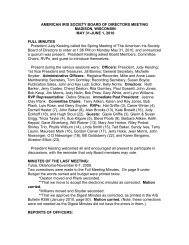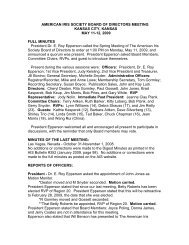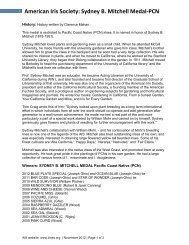contemporary views – 1988 award winners - American Iris Society
contemporary views – 1988 award winners - American Iris Society
contemporary views – 1988 award winners - American Iris Society
Create successful ePaper yourself
Turn your PDF publications into a flip-book with our unique Google optimized e-Paper software.
egistered: ANN BLOCHER (Blocher 1990). Clarence has named this in honor and memory of his late wife. ‘Ann<br />
Blocher’, entered by Dale Satterwhite for Mr. Blocher, won Best Seedling at the Tulsa show. It was such an incredible<br />
show stalk that it would have easily been a contender (or winner) of the Queen of Show honors, had it been introduced. It<br />
is a big, full formed cold white with a self beard, completely adorned with light ruffling and heavy lace. In spite of the<br />
intensity of the lace, the flowers open with ease with no “assistance” required. From totally different bloodlines than the<br />
Schreiners’ laced whites and last year’s L’Elegante recipient, ‘Bubbling Lace’ (Black). It comes from the laced blue<br />
classic, ‘Charisma’ (Blocher), and should not even be compared, for it is a totally different style than ‘Bubbling Lace’ and<br />
the others. It also inherited ‘Charisma’s’ candelabra show stalk branching.<br />
Runnersup:<br />
VICTORIAN FRILLS (Black <strong>1988</strong>) is the ultimate in smoothness in light peach-apricot tones. The broad flowers have<br />
perfect symmetry, and as with ‘Ann Blocher’, open easily and gracefully in spite of the heavy lace. A shorter variety from<br />
strong Kegerise bloodlines; I have no problem with its height. The branching is perfectly spaced. I usually find those<br />
with triple sockets to be objectionable because the third bud in the socket rarely develops to a representative flower. Such<br />
was not the case with ‘Victorian Frills’. SHEER CLASS (L. Miller <strong>1988</strong>) is a new SDB that took us by storm. A rich<br />
rose-pink that is actually approximating watermelon in color, with a hint of a ray pattern in the falls surrounding bright<br />
corals beards. Although from “mixed” breeding -- the small-flowered IB, ‘Pink Kitten’ (Wood), crossed by the great SDB<br />
parent, ‘Inscription’ (Boushay) -- I found the flower size, foliage, height, and thickness of the stalks to be at the upper range<br />
of the SDBs, but still well within the class requirements, and the specimen viewed was grown in rich soil. The substance<br />
and texture are especially noteworthy. A perfect name for a median that will remain popular for years to come.<br />
CHURCHILL DOWNS (K. Mohr <strong>1988</strong>) is a clean, pleasant, medium lemon yellow with a patch of lighter color (near<br />
white) in the center of the falls around yellow beards. The emphasis here is on the form and the diamond dusting of the<br />
flowers which aid it in remaining colorfast here. Moderate lace on all parts. Average branching and bud count that is a bit<br />
lean (5 buds this year), but the length of time the flowers remain open compensates. The flowers also retain their substance<br />
until they fold, which is most commendable in this color.<br />
3. The 9-1-1 AWARD is given to the New <strong>Iris</strong> that is the most significant hybridizing achievement or color break. This<br />
year’s winner is the new Space Age iris, CONJURATION (Byers 1989). As viewed in Memphis at the master planting<br />
at Ketchum, it was a tall, commanding “amoena” in the tradition of its parent, ‘Alpine Castle’ (Blyth), but with<br />
drastically improved form. The stalks were somewhat thin, but tall and stately, and holding up average sized flowers with<br />
no problem in light rain and wind. Exceptionally vigorous and floriferous, it makes a smashing clump, but I feel it will<br />
also consistently produce show stalks. The color scheme is basically a white infused lilac-lavender, with the falls heavily<br />
washed on the edges in amethyst in the style of ‘Planned Treasure’ (Burger) or ‘Fuji’s Mantle’ (Schreiner). All of this is<br />
capped with consistent, bright tangerine beards and horns! A great breakthrough.<br />
Runnersup:<br />
DANCE AWAY (Hamblen <strong>1988</strong>). Although the henna/sienna bearded burnished look is becoming more common now,<br />
‘Dance Away’ still deserves attention as a color break. Rich cocoa-pink is infused with violet undertones.<br />
Complementary warm ivory white falls are then banded with the principal color. All this is capped with sizzling deep<br />
sienna beards. You just won’t believe it until you see it. Of course the form, substance, and plant habits are up to<br />
<strong>contemporary</strong> standards <strong>–</strong> it’s a Hamblen iris! Another Byers Space Age introduction receives the next runnerup position:<br />
LOVEBIRD (<strong>1988</strong>), my personal favorite of Monty’s Space Age releases so far. It is a short, small-flowered, delicate pink<br />
based plicata, stitched in harmonious light red-violet, with fuzzy red-violet horns. The flowers are laced and have<br />
exceptionally good form and substance. And PURGATORY (Moores 1987) is technically a variegata, but unlike anything<br />
on the market. Average plants and stalks produce flowers that are smoldering, with shades of deep bronze in the standards<br />
and deeper, even richer falls. The whole flower is underlaid with tones of bronze, mahogany, and burnished reds and<br />
bronzes. The substance and resistance to inclement weather are especially noteworthy in this completely sunfast new iris.<br />
4. The SUN BELT AWARD is given to the Best Proven variety, i.e., one that has been on the market at least 4 years.<br />
This year’s selection was the most difficult of all <strong>award</strong>s to decide, with the nod finally going to HOUDINI (Maryott<br />
1985). It resembles its pod parent, ’Midnight Special’ (Sexton), in basic color scheme, being a rich deep violet with even<br />
deeper falls. The whole flower has gloss like nail polish, and the falls very nearly approach a shiny black. The branching is<br />
somewhat variable, but it has stronger plants that are more resistant to late freezes and less prone to rot than ‘Midnight<br />
Special’. It is gratefully an earlier bloomer than most of the blacks on the market. It is simply smashing both in the<br />
garden and on the show bench.<br />
16
















